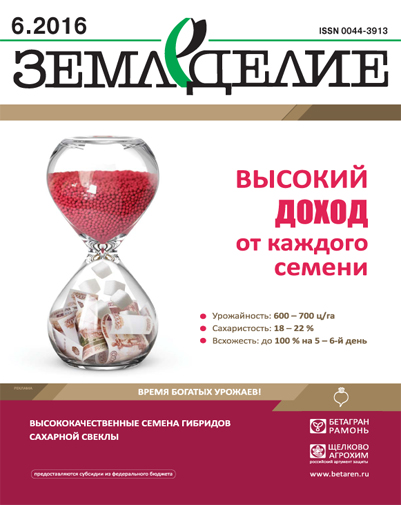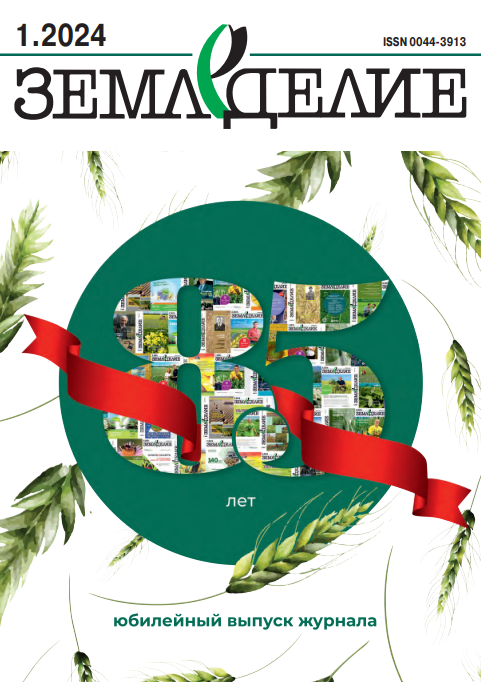Урожайность и качество зерна озимой пшеницы в зависимости от средств химизации в условиях радиоактивного загрязнения
Земледелие, 2016, № 6
УДК 633.11:539.16
Е.В. СПРАВЦЕВА, аспирант
Адрес электронной почты защищен от спам-ботов. Для просмотра адреса в вашем браузере должен быть включен Javascript.
Брянский государственный аграрный университет, ул. Советская 2а, с. Кокино, Выгоничский р-он, Брянская обл., 243365, Российская Федерация
Брянский государственный аграрный университет, ул. Советская 2а, с. Кокино, Выгоничский р-он, Брянская обл., 243365, Российская Федерация
Цель исследований – оценка эффективности применения различных доз и сочетаний минеральных удобрений и биопрепарата Гумистим при выращивании озимой пшеницы на дерново-среднеподзолистой легкосуглинистой почве в условиях радиоактивного загрязнения территории, их влияния на урожайность и качество зерна. Полевые опыты проводили в четырехпольном севообороте в 2014-2015 гг. на дерновосреднеподзолистой легкосуглинистой почве с содержанием органического вещества 2,00-2,63%, подвижного фосфора и обменного калия (по Кирсанову) соответственно 348-512 и 76-155 мг/кг почвы, pHКCl 5,28-5,48, плотность загрязнения почвы 137Cs – 216-248 кБк/м2. В факториальном эксперименте изучали влияние различных доз минеральных удобрений, как при отдельном внесении, так и в комплексе с биопрепаратом Гумистим, на урожайность и качество зерна озимой пшеницы. Норма высева – 5,5 млн всхожих зерен на 1 га, способ посева – рядовой. Срок посева – третья декада августа. Посевы обрабатывали биопрепаратом Гумистим весной в фазу кущения из расчета расхода препарата 6 л/га. Выявлено, что урожайность зерна озимой пшеницы по изучаемым вариантам опыта изменялась от 1,27 до 3,29 т/га, наибольшую урожайность зерна озимой пшеницы в среднем за годы исследований (3,29 т/га) обеспечило применение полного минерального удобрения N120P90K150 в комплексе с биопрепаратом Гумистим. Наиболее высокое содержание сырого белка в зерне озимой пшеницы (13,43%) и наибольший сбор сырого белка (0,44 т/га) также отмечены в этом варианте. Самое высокое содержание сырой клейковины в зерне озимой пшеницы (31,1%) в среднем за годы опыта зафиксировано в варианте N120P90K150+Гумистим. Наибольшая кратность снижения удельной активности 137Cs (в 1,98 раза в среднем за годы опыта) отмечена при комплексном применении полного минерального удобрения N120P90K150 и биопрепарата Гумистим.
Ключевые слова: озимая пшеница, урожайность, удобрения, биопрепарат Гумистим, сырой белок, клейковина, 137Cs.
Для цитирования: Справцева Е.В. Урожайность и качество зерна озимой пшеницы в зависимости от средств химизации в условиях радиоактивного загрязнения // Земледелие. 2016. № 6. С. 31-35.
Productivity and Quality of Winter Wheat Grain Depending on Chemicalization Means under Conditions of Radioactive Pollution
E.V. Spravtseva
Bryansk State Agricultural University, ul. Sovetskaya, 2a, s. Kokino, Vygonichsky r-n, Bryanskaya obl., 243365, Russian Federation
The aim of our investigations was to estimate the efficiency of application of different doses and combinations of mineral fertilizers and the Gumistim biological preparation during cultivation of winter wheat on sod medium podzol sandy loam soil under conditions of radioactive pollution of the territory. We also wanted to determine their influence on productivity and grain quality. The field experiments were carried out in four-field crop rotation in 2014-2015 on the sod medium podzol sandy loam soil with the content of organic matter 2.00- 2.63%, of mobile phosphorus and exchange potassium (according to Kirsanov) 348-512 and 76-155 mg/kg of the soil, respectively, pH(KCl) was 5.28-5.48, the density of pollution of the soil by Cs-137 was 216-248 kBq/ sq.m. In the factorial experiment it was studied the influence of various doses of mineral fertilizers both at separate application and in the complex with the Gumistim biological preparation on productivity and quality of grain of winter wheat. The seeding rate was 5.5 million of grains per a hectare, the seeding method was row. The sowing time was the third decade of August. Processing of crops by the biological product Gumistim was carried out in the spring at the tillering phase at the rate of 6 l/ha. It was revealed that the yield of grain of winter wheat among the studied variants changed from 1.27 to 3.29 t/ha, the maximum productivity of grain of winter wheat on average over the years of the investigation (3.29 t/ha) was provided by the use of the full mineral fertilizer N120P90K150 in the combination with the biological preparation Gumistim. The highest content of crude protein in grain of winter wheat (13.43%) and the greatest harvest of crude protein (0.44 t/ha) was also registered in this variant. The highest content of crude gluten in grain of winter wheat (31.1%) on average for the years of the test was noted in the variant N120P90K150 + Gumistim. The greatest decrease in specific activity of Cs-137 (on average 1.98 times) was noted at the complex use of the full mineral fertilizer N120P90K150and the biological product Gumistim.
Keywords: winter wheat, productivity, fertilizers, biological preparation Gumistim, crude protein, gluten, Cs-137.
Author Details: E.V. Spravtseva, postgraduate student (e-mail: Адрес электронной почты защищен от спам-ботов. Для просмотра адреса в вашем браузере должен быть включен Javascript.)
For citation: Spravtseva E.V. Productivity and Quality of Winter Wheat Grain Depending on Chemicalization Means under Conditions of Radioactive Pollution. Zemledelie. 2016. №6. Pp. 31-35 (in Russ.).










